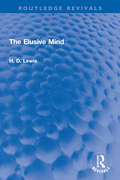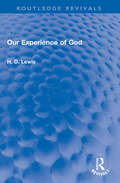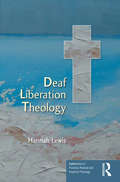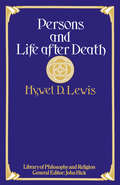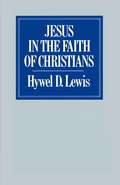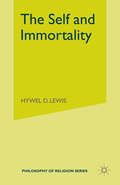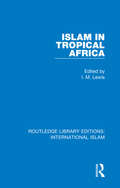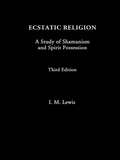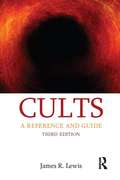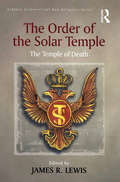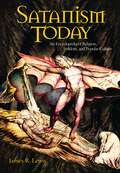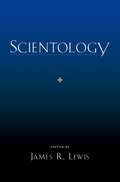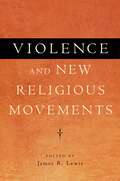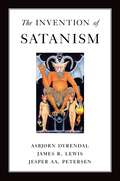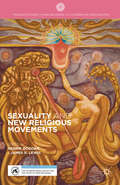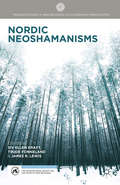- Table View
- List View
The Elusive Mind (Routledge Revivals)
by H. D. LewisFirst published in 1969, The Elusive Mind argues that the mental processes are of a quite different nature from physical ones and belong to an entity which is elusive in the sense that it can only be known, in the first instance, by each person in his own case in the course of having any kind of experience. This ‘elusive’ self is much involved with the body in any conditions we know, but it could also survive the dissolution of the body. The views of thinkers like Ryle, Hampshire, Malcolm, Feigl, and Ayer are subjected to an exceptionally close and critical scrutiny. In presenting these views, the author offers us the substance of the first series of Gifford Lectures he delivered in the University of Edinburgh; and, in what he says on such topics as dreaming; mysticism; and the ‘I-Thou’ relation and on Christian Theology. This book will be an essential read for scholars and researchers of philosophy, philosophy of mind, ethics, and religion.
The Elusive Mind (Routledge Revivals)
by H. D. LewisFirst published in 1969, The Elusive Mind argues that the mental processes are of a quite different nature from physical ones and belong to an entity which is elusive in the sense that it can only be known, in the first instance, by each person in his own case in the course of having any kind of experience. This ‘elusive’ self is much involved with the body in any conditions we know, but it could also survive the dissolution of the body. The views of thinkers like Ryle, Hampshire, Malcolm, Feigl, and Ayer are subjected to an exceptionally close and critical scrutiny. In presenting these views, the author offers us the substance of the first series of Gifford Lectures he delivered in the University of Edinburgh; and, in what he says on such topics as dreaming; mysticism; and the ‘I-Thou’ relation and on Christian Theology. This book will be an essential read for scholars and researchers of philosophy, philosophy of mind, ethics, and religion.
Our Experience of God (Routledge Revivals)
by H. D. LewisFirst published in 1959, Our Experience of God examines the relationship between philosophy and religion. The author argues that, we cannot construct a religion for ourselves out of merely philosophical elements, and that the attempt to provide some philosophical or similar substitute for religion, as it normally presents itself, is misconceived. It brings themes like religion and belief; belief and mystery; religion and transcendence; history and dogma; material factors in religion; symbolism and tradition; art and religion; religion and morality; and encounter and immediacy, to show that the place of philosophy in religion is not to provide proofs for beliefs but to make more explicit for us what is the nature and status of the beliefs we do hold and commend to others. This book will be of interest to scholars and researchers of religion, philosophy, and theology.
Our Experience of God (Routledge Revivals)
by H. D. LewisFirst published in 1959, Our Experience of God examines the relationship between philosophy and religion. The author argues that, we cannot construct a religion for ourselves out of merely philosophical elements, and that the attempt to provide some philosophical or similar substitute for religion, as it normally presents itself, is misconceived. It brings themes like religion and belief; belief and mystery; religion and transcendence; history and dogma; material factors in religion; symbolism and tradition; art and religion; religion and morality; and encounter and immediacy, to show that the place of philosophy in religion is not to provide proofs for beliefs but to make more explicit for us what is the nature and status of the beliefs we do hold and commend to others. This book will be of interest to scholars and researchers of religion, philosophy, and theology.
Deaf Liberation Theology (Explorations in Practical, Pastoral and Empirical Theology)
by Hannah LewisFollowing years of theology of deafness based on the premise that Deaf people are simply people who cannot hear, this book breaks new ground. Presenting a new approach to Deaf people, theology and the Church, this book enables Deaf people who see themselves as members of a minority group to formulate their own theology rooted in their own history and culture. Deconstructing the theology and practice of the Church, Hannah Lewis shows how the Church unconsciously oppresses Deaf people through its view of them as people who cannot hear. Lewis reclaims Deaf perspectives on Church history, examines how an essentially visual Deaf culture can relate to the written text of the Bible and asks 'Can Jesus sign?' This book pulls together all these strands to consider how worship can be truly liberating, truly a place for Deaf people to celebrate who they are before God.
Deaf Liberation Theology (Explorations in Practical, Pastoral and Empirical Theology)
by Hannah LewisFollowing years of theology of deafness based on the premise that Deaf people are simply people who cannot hear, this book breaks new ground. Presenting a new approach to Deaf people, theology and the Church, this book enables Deaf people who see themselves as members of a minority group to formulate their own theology rooted in their own history and culture. Deconstructing the theology and practice of the Church, Hannah Lewis shows how the Church unconsciously oppresses Deaf people through its view of them as people who cannot hear. Lewis reclaims Deaf perspectives on Church history, examines how an essentially visual Deaf culture can relate to the written text of the Bible and asks 'Can Jesus sign?' This book pulls together all these strands to consider how worship can be truly liberating, truly a place for Deaf people to celebrate who they are before God.
Islam in Tropical Africa (Routledge Library Editions: International Islam #4)
by I. M. LewisFirst published in 1980, this second edition of Islam in Tropical Africa presents specialist studies of the history and sociology of Muslim communities in Africa south of the Sahara. The studies cover an extensive and range of time and place, and include consideration of particular aspects of Muslim belief and practice in regions such as Senegal and Somalia. The second edition includes an updated introduction which draws attention to the ways in which differently organized traditional cultures and social systems had reacted and adapted to Muslim influence in the field of politics, law and ritual in the second half of the twentieth century. This book will be of interest to those studying Islam, African studies and ethnography.
Islam in Tropical Africa (Routledge Library Editions: International Islam #4)
by I. M. LewisFirst published in 1980, this second edition of Islam in Tropical Africa presents specialist studies of the history and sociology of Muslim communities in Africa south of the Sahara. The studies cover an extensive and range of time and place, and include consideration of particular aspects of Muslim belief and practice in regions such as Senegal and Somalia. The second edition includes an updated introduction which draws attention to the ways in which differently organized traditional cultures and social systems had reacted and adapted to Muslim influence in the field of politics, law and ritual in the second half of the twentieth century. This book will be of interest to those studying Islam, African studies and ethnography.
Ecstatic Religion: A Study of Shamanism and Spirit Possession
by I.M. LewisFirst Published in 2004. Routledge is an imprint of Taylor & Francis, an informa company.
Ecstatic Religion: A Study of Shamanism and Spirit Possession
by I.M. LewisFirst Published in 2004. Routledge is an imprint of Taylor & Francis, an informa company.
Cults: A Reference and Guide (Approaches to New Religions)
by James R. LewisCults examines the history and current status of cults across the United States, Europe, and East Asia. Focusing on the principal controversial religions and movements that have attracted major media attention, the book also includes profiles of hundreds of minority religions, from Jesus People and Rastafarians to voodoo practitioners and the human-cloning Raelians. All the issues central to the practice and the fear of cults are examined - apocalypticism, deprogramming, social isolation, cults and the media, the use and threat of violence, child custody, libel, tax evasion, solicitation, and the techniques of persuasion and conviction - as are the many charismatic cult leaders. Cults presents a comprehensive and authoritative reference, offering a balanced view of the controversy surrounding these new religious movements, assessing the movements themselves as well as the legal and governmental responses to them, including attempts to quantify membership.
Cults: A Reference and Guide (Approaches to New Religions)
by James R. LewisCults examines the history and current status of cults across the United States, Europe, and East Asia. Focusing on the principal controversial religions and movements that have attracted major media attention, the book also includes profiles of hundreds of minority religions, from Jesus People and Rastafarians to voodoo practitioners and the human-cloning Raelians. All the issues central to the practice and the fear of cults are examined - apocalypticism, deprogramming, social isolation, cults and the media, the use and threat of violence, child custody, libel, tax evasion, solicitation, and the techniques of persuasion and conviction - as are the many charismatic cult leaders. Cults presents a comprehensive and authoritative reference, offering a balanced view of the controversy surrounding these new religious movements, assessing the movements themselves as well as the legal and governmental responses to them, including attempts to quantify membership.
The Order of the Solar Temple: The Temple of Death (Routledge New Religions)
by James R. LewisIn October 1994, fifty-three members of the Order of the Solar Temple in Switzerland and Québec were murdered or committed suicide. This incident and two later group suicides in subsequent years played a pivotal role in inflaming the cult controversy in Europe, influencing the public to support harsher actions against non-traditional religions. Despite the importance of the Order of the Solar Temple, there are relatively few studies published in English. This book brings together the best scholarship on the Solar Temple including newly commissioned pieces from leading scholars, a selection of Solar Temple documents, and important previously published articles newly edited for inclusion within this book. This is the first book-length study of the Order of the Solar Temple to be published in English.
The Order of the Solar Temple: The Temple of Death (Routledge New Religions)
by James R. LewisIn October 1994, fifty-three members of the Order of the Solar Temple in Switzerland and Québec were murdered or committed suicide. This incident and two later group suicides in subsequent years played a pivotal role in inflaming the cult controversy in Europe, influencing the public to support harsher actions against non-traditional religions. Despite the importance of the Order of the Solar Temple, there are relatively few studies published in English. This book brings together the best scholarship on the Solar Temple including newly commissioned pieces from leading scholars, a selection of Solar Temple documents, and important previously published articles newly edited for inclusion within this book. This is the first book-length study of the Order of the Solar Temple to be published in English.
Satanism Today: An Encyclopedia of Religion, Folklore, and Popular Culture
by James R. LewisThis authoritative reference work presents a full image of the Prince of Darkness as he appears throughout traditional theology, mythology, art and literature, and popular culture.This nonsensationalist encyclopedia examines contemporary images of the devil and sorts out the many different forms these images take. Although much of the myths relating to Satan derive directly or indirectly from the Christian tradition, the key sources of diabolical images today are horror movies, heavy metal music, and conservative Christian literature.This encyclopedia gives a brief overview depicting the history and transformation of the meaning of the Prince of Darkness, and 300 entries cover subjects like the angel of death, backward masking (messages revealed when songs are played backward), neopagan witchcraft, UFOs, and The Satanic Bible. Extensive appendixes include the l992 FBI study of satanic ritual abuse, the most influential document ever written on the subject, as well as sample satanic scriptures and a satanic wedding ceremony. Satanism Today also includes a chronology, bibliographies, and references.
Scientology (Brill Handbooks On Contemporary Religion Ser. #14)
by James R. LewisScientology is arguably the most persistently controversial of all contemporary New Religious Movements. James R. Lewis has assembled an unusually comprehensive anthology, incorporating a wide range of different approaches. In this book, a group of well-known scholars of New Religious Movements offers an extensive and evenhanded overview and analysis of all of these aspects of Scientology, including the controversies to which it continues to give rise.
Scientology
by James R. LewisScientology is arguably the most persistently controversial of all contemporary New Religious Movements. James R. Lewis has assembled an unusually comprehensive anthology, incorporating a wide range of different approaches. In this book, a group of well-known scholars of New Religious Movements offers an extensive and evenhanded overview and analysis of all of these aspects of Scientology, including the controversies to which it continues to give rise.
Violence and New Religious Movements
by James R. LewisThe relationship between new religious movements (NRMs) and violence has long been a topic of intense public interest--an interest heavily fueled by multiple incidents of mass violence involving certain groups. Some of these incidents have made international headlines. When New Religious Movements make the news, it's usually because of some violent episode. Some of the most famous NRMs are known much more for the violent way they came to an end than for anything else. Violence and New Religious Movements offers a comprehensive examination of violence by-and against-new religious movements. The book begins with theoretical essays on the relationship between violence and NRMs and then moves on to examine particular groups. There are essays on the "Big Five"--the most well-known cases of violent incidents involving NRMs: Jonestown, Waco, Solar Temple, the Aum Shunrikyo subway attack, and the Heaven's Gate suicides. But the book also provides a richer survey by examining a host of lesser-known groups. This volume is the culmination of decades of research by scholars of New Religious Movements.
Violence and New Religious Movements
by James R. LewisThe relationship between new religious movements (NRMs) and violence has long been a topic of intense public interest--an interest heavily fueled by multiple incidents of mass violence involving certain groups. Some of these incidents have made international headlines. When New Religious Movements make the news, it's usually because of some violent episode. Some of the most famous NRMs are known much more for the violent way they came to an end than for anything else. Violence and New Religious Movements offers a comprehensive examination of violence by-and against-new religious movements. The book begins with theoretical essays on the relationship between violence and NRMs and then moves on to examine particular groups. There are essays on the "Big Five"--the most well-known cases of violent incidents involving NRMs: Jonestown, Waco, Solar Temple, the Aum Shunrikyo subway attack, and the Heaven's Gate suicides. But the book also provides a richer survey by examining a host of lesser-known groups. This volume is the culmination of decades of research by scholars of New Religious Movements.
The Invention of Satanism
by James R. Lewis Asbjorn Dyrendal Jesper Aa. PetersenSatanism is a complex phenomenon that has often been the source of controversy across social and rhetorical contexts. Some consider it the root of all evil. Others see it as a childish form of rebellion or as a misapplication of serious esoteric beliefs and practices. Still others consider it a specific religion or philosophy that serves as a form of personal and collective identity. In The Invention of Satanism, three experts explore Satanism as a contemporary movement that is in continuous dialogue with popular culture, and which provides a breeding ground for other new religious movements. By shifting the focus from mythology to meaning-making, this book examines the invention of Satanism among self-declared religious Satanists. Like all ideologists and believers, Satanists incorporate, borrow, and modify elements from other traditions; the authors investigate how traditional folklore and prior strands of occultism were synthesized by Anton LaVey in his founding of the Church of Satan and creation of the Satanic Bible. Later chapters discuss contemporary Satanist subcultures, demonstrating how Satanism continues to reinvent itself despite its brief history as an organized phenomenon. There are now numerous forms of Satanism with distinctive interpretations of what being a Satanist entails, with some of these new versions deviating more from the historical "mainstream" than others. In this fascinating account of a seemingly arcane and often-feared movement, Dyrendal, Lewis, and Petersen demonstrate that the invention of Satanism is an ongoing, ever-evolving process.
Sexuality and New Religious Movements (Palgrave Studies in New Religions and Alternative Spiritualities)
by James R. Lewis Edited by Henrik BogdanIssues relating to sexuality, eroticism and gender are often connected to religious beliefs and practices, but also to prejudices against and fear of religious groups that adopt alternative approaches to sexuality. This is especially apparent in connection with new religious movements, which many times find themselves accused by the media and anti-cultists of promoting illicit and controversial views on sexuality. This anthology aims to critically investigate the role of sexuality in a number of new religious movements, including Mormon fundamentalist communities, the Branch Davidians, the Osho movement, the Raël movement, contemporary Wicca and Satanism, in addition to the teachings of Adidam and Gurdjieff on sexuality.
Nordic Neoshamanisms (Palgrave Studies in New Religions and Alternative Spiritualities)
by James R. Lewis Siv Ellen Kraft Trude FonnelandThis book proposes that the drive for religiosity and experiences of the sacred are far from lost in contemporary western societies. The contributors' objective is to explore the myriad of ways late modern shamanism is becoming more vital and personally significant to people, communities, and economies in Nordic countries.
